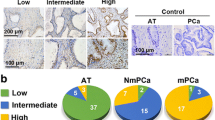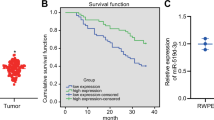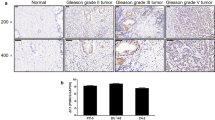Abstract
Prostate cancer is a lethal cancer for the invasion and metastasis in its earlier period. P53 is a tumor suppressor gene which plays a critical role on safeguarding the integrity of genome. However, loss of P53 facilitates or inhibits the invasion and metastasis of tumor is still suspended. In this study, we are going to explain whether loss of P53 affect the invasion and metastasis of prostate cancer cells. To explore whether loss of P53 influences the invasion and metastasis ability of prostate cancer cells, we first compared the invasion ability of si-P53 treated cells and control cells by wound healing, transwell assay, and adhesion assay. We next tested the activity of MMP-2, MMP-9, and MMP-14 by western blot and gelatin zymography. Moreover, we employed WB and IF to identify the EMT containing E-cad, N-cad, vimentin, etc. We also examined the expression of cortactin, cytoskeleton, and paxillin by immunofluorescence, and tested the expression of ERK and JNK by WB. Finally, we applied WB to detect the expression of FAK, Src, and the phosphorylation of them to elucidate the mechanism of si-P53 influencing invasion and metastasis. According to the inhibition rate of si-P53, we choose the optimized volume of si-P53. With the volume, we compare the invasion and metastasis ability of Du145 and si-P53 treated cells. We find si-P53 promotes the invasion and metastasis in prostate cancer cells, increases the expression and activity of MMP-2/9 and MMP-14. Also, si-P53 promotes EMT and cytoskeleton rearrangement. Further analyses explain that this effect is associated with FAK-Src signaling pathway. Loss of P53 promotes the invasion and metastasis ability of prostate cancer cells and the mechanism is correlated with FAK-Src signaling pathway. P53 is involved in the context of invasion and metastasis.




Similar content being viewed by others
References
Atlanta, Ga, Cancer Facts and Figures 2012, American Cancer Society, 2012
Orr FW, Sanchez-Sweatman OH, Kostenuik P et al (1995) Tumor-bone interactions in skeletal metastasis. Clin Orthop 312:19–33
Mundy GR (1997) Mechansims of bone metastasis. Cancer (Phila.) 80:1546–1556
Scalliet P (1996) Carcinoma of the prostate: treatment of bone metastasis. Acta Urol Belg 64:87–90
Carter HB, Coffey DS (1990) The prostate: an increasing medical problem. Prostate 16:39–48
Murray-Zmijewski F, Slee EA, Lu X (2008) A complex barcode underlies the heterogeneous response of p53 to stress. Nat Rev Mol Cell Biol 9:702–712
Vousden KH, Prives C (2009) Blinded by the light: the growing complexity of p53. Cell 173:413–431
Muller PA, Vousden KH, Norman JC (2011) p53 and its mutants in tumor cell migration and invasion. J Cell Biol 192:209–218
Elgavish A, Wood PA, Pinkert CA et al (2004) Transgenic mouse with human mutant p53 expression in the prostate epithelium. Prostate 61:26–34
Olive KP, Tuveson DA, Ruhe ZC et al (2004) Mutant p53 gain of function in two mouse models of Li-Fraumeni syndrome. Cell 119:847–860
Muller PA, Caswell PT, Doyle B et al (2009) Mutant p53 drives invasion by promoting integrin recycling. Cell 139:1327–1341
Gadea G, de Toledo M, Anguille C et al (2007) Loss of p53 promotes RhoA-ROCK-dependent cell migration and invasion in 3D matrices. J Cell Biol 178:23–30
Roger L, Gadea G, Roux P (2006) Control of cell migration: a tumour suppressor function for p53? Biol Cell 98:141–152
Kemp CJ, Donehower LA, Bradley A et al (1993) Reduction of p53 gene dosage does not increase initiation or promotion but enhances malignant progression of chemically induced skin tumors. Cell 74:813–822
Harrington EA, Fanidi A, Evan GI (1994) Oncogenes and cell death. Curr Opin Genet Dev 4:120–129
Golubovskaya VM, Finch R, Kweh F et al (2008) p53 regulates FAK expression in human tumor cells. Mol Carcinog 47:373–382
Mitra SK, Schlaepfer DD (2006) Integrin-regulated FAK–Src signaling in normal and cancer cells. Curr Opin Cell Biol 18:516–523
Hernandez-Barrantes S, Toth M, Bernardo MM et al (2000) Binding of active (57 kDa) membrane type 1-matrix metalloproteinase (MT1-MMP) to tissue inhibitor of metalloproteinase (TIMP)-2 regulates MT1-MMP processing and pro-MMP-2 activation. J Biol Chem 275:12080–12089
M Margarida Bernardo and Rafael Fridman (2003) TIMP-2 (tissue inhibitor of metalloproteinase-2) regulates MMP-2 (matrix metalloproteinase-2) activity in the extracellular environment after pro-MMP-2 activation by MT1 (membrane type 1)-MMP. Biochem J 374:739–745
Lin S, Yu L, Yang J et al (2011) Mutant p53 disrupts role of ShcA protein in balancing Smad protein-dependent and -independent signaling activity of transforming growth factor-β (TGF-β). J Biol Chem 286:44023–44034
Schlaepfer DD, Mitra SK (2004) Multiple connections link FAK to cell motility and invasion. Curr Opin Genet Dev 14:92–101
Parsons JT (2003) Focal adhesion kinase: the first ten years. J Cell Sci 116:1409–1416
Harburger DS, Calderwood DA (2009) Integrin signalling at a glance. J Cell Sci 122:159–163
Wang W, Liu Y, Liao K (2011) Tyrosine phosphorylation of cortactin by the FAK-Src complex at focal adhesions regulates cell motility. BMC Cell Biol 12:49
Michael DS (2001) Paxillin: a focal adhesion-associated adaptor protein. Oncogene 20:6459–6472
Conflict of interests
The authors have declared that no conflict of interests exist.
Author information
Authors and Affiliations
Corresponding author
Rights and permissions
About this article
Cite this article
Wang, Y., Zhang, Y.X., Kong, C.Z. et al. Loss of P53 facilitates invasion and metastasis of prostate cancer cells. Mol Cell Biochem 384, 121–127 (2013). https://doi.org/10.1007/s11010-013-1789-1
Received:
Accepted:
Published:
Issue Date:
DOI: https://doi.org/10.1007/s11010-013-1789-1




